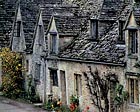Property in Gloucestershire
One of the most sought-after counties in England, Gloucestershire is known for fine food, idyllic houses and rolling landscape


The county Gloucestershire's rolling hills, high hedges and dense forests constitute the largest Area of Outstanding Natural Beauty in Britain and ensure the county is unfailingly popular. But although it is in essence a rural county with a wealth of traditional farms, Gloucestershire has always been supported by thriving industries. A rip-roaring wool trade in medieval times earned the county enough money to grace each village with a handsome church and rich merchants built fine country houses ? which are now fought over by potential buyers. With good transport and high quality of life, the county is popular with country-loving folk who need to be within easy reach of London. Prince Charles and Princess Anne have brought up their families in Gloucestershire ? the Highgrove Estate is famed for organic farming whilst Gatcombe Park hosts the Festival of British Eventing. Geographically the county is split into three areas: the Cotswolds with its pretty, mellow stone houses, the Royal Forest of Dean and the Severn Vale. Gloucester and Cheltenham lie at the heart of the county, linked by the A40 and either side of the M5. The motorway marks a dividing line between the picturesque Cotswolds to the east and the forest of Dean to the west ? once described as 'the most beautiful assembly of trees in England'. According to Rupert Sweeting from Knight Frank prime country houses in Gloucestershire usually fetch more than their guide price, with houses to west of the M5 often 10% to 20% better value. Country houses in the sought after Coln Valley to the east of Cirencester and the Duntisbourne Valley to the north sell for a premium. Chipping Norton and villages close to Cheltenham are popular with purchasers and cheaper houses can be found around Stroud and towards Swindon ? which according to Jamie Hamilton from Jackson-Stops and Staff, has 'negative gravity.' The market Gloucerstershire's property market is 'fairly cushioned' according to Mr Hamilton, with prices driven almost entirely by the continuing lack of good quality properties for sale. 'Each year the shortage gets worse,' he explains. Prices have gone up by 10% over the course of 2006 with good condition houses staying on the market for less then a month. But according to Mr Dalrymple Hamilton the market is two-tiered, with those properties over £1 million entering a strong, active market but those with cheaper price tags staying on the shelf as buyers think hard about mortgage rates. Prices of properties worth £2 million or more ('premium properties') are witnessing a real thrust, according to Steven Perks from Hamptons International. Mr Hamilton believes the key to quick selling is to make sure your property is in good decorative order. 'A well done-up house will sell much more easily than a badly decorated house of the same square footage,' he explained.
Sign up for the Country Life Newsletter
Exquisite houses, the beauty of Nature, and how to get the most from your life, straight to your inbox.
Country Life is unlike any other magazine: the only glossy weekly on the newsstand and the only magazine that has been guest-edited by HRH The King not once, but twice. It is a celebration of modern rural life and all its diverse joys and pleasures — that was first published in Queen Victoria's Diamond Jubilee year. Our eclectic mixture of witty and informative content — from the most up-to-date property news and commentary and a coveted glimpse inside some of the UK's best houses and gardens, to gardening, the arts and interior design, written by experts in their field — still cannot be found in print or online, anywhere else.
-
 Six rural properties with space, charm and endless views, as seen in Country Life
Six rural properties with space, charm and endless views, as seen in Country LifeWe take a look at some of the best houses to come to the market via Country Life in the past week.
By Toby Keel Published
-
 Exploring the countryside is essential for our wellbeing, but Right to Roam is going backwards
Exploring the countryside is essential for our wellbeing, but Right to Roam is going backwardsCampaigners in England often point to Scotland as an example of how brilliantly Right to Roam works, but it's not all it's cracked up to be, says Patrick Galbraith.
By Patrick Galbraith Published
